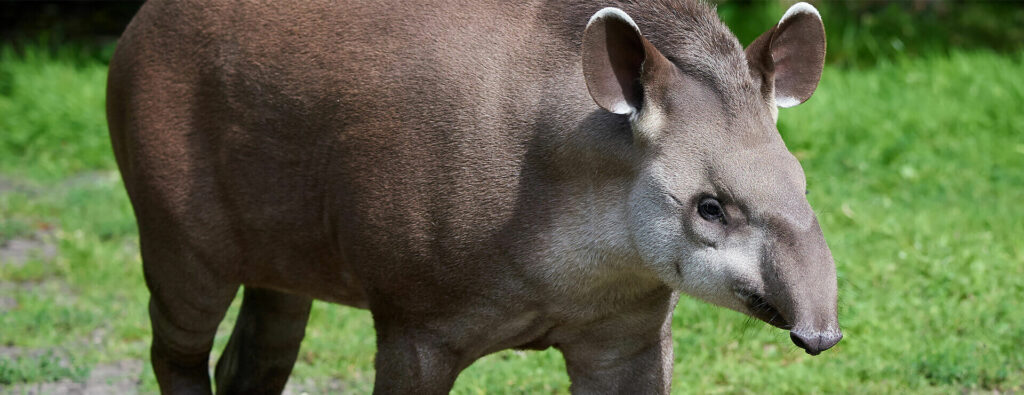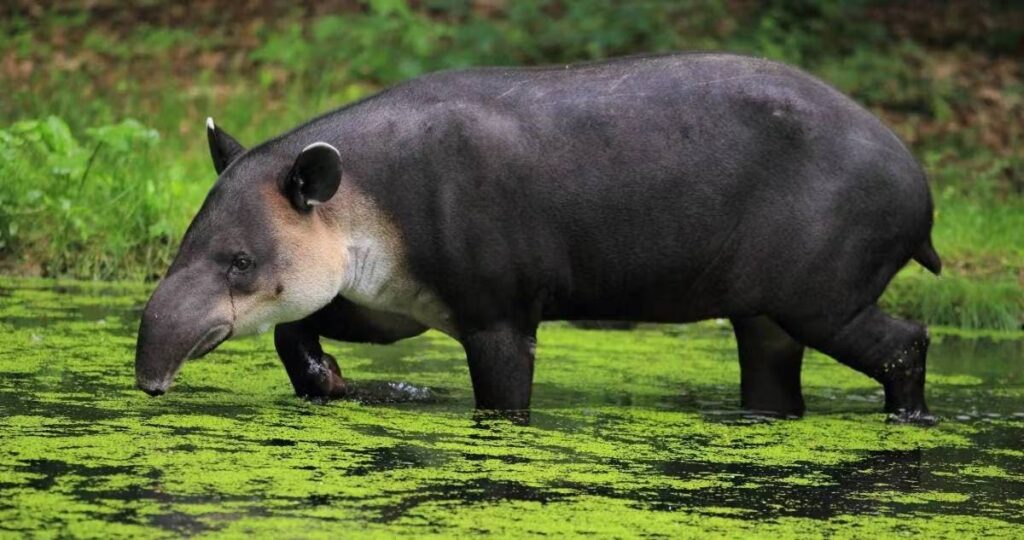Why is the Tapir a “living fossil”?

In the heart of dense rainforests of our planet, a creature roams silently, embodying a timeless legacy that spans millions of years. The Tapir, often referred to as a “living fossil”, holds secrets of the past within its very essence, offering a window into bygone eras of Earth’s history.
Ancient Creatures
Tapirs trace their origins back to a group of primitive perissodactyls known as the “tapiroids”, which roamed North America and Asia during the Eocene epoch. From these ancient ancestors, Tapirs emerged as a distinct family, Tapiridae, with their oldest known members such as Protapirus appearing in the Early Oligocene of Europe.
As time progressed, Tapirus diversified and dispersed across continents. The modern genus Tapirus first emerged in Europe during the Mid-Miocene, eventually spreading into Asia and North America by the late Miocene. However, Tapirs became extinct in Europe by the end of the Pliocene, marking a significant shift in their distribution.
The Great American Biotic Interchange during the Pleistocene facilitated Tapir’s dispersal into South America, with the earliest records on the continent dating back approximately 2.6 to 1 million years ago. This migration led to the establishment of Tapir populations in the diverse ecosystems of South America, where they continue to thrive today.
Low Genetic Diversity
Genetic studies have provided valuable insights into Tapir evolution and diversity. The Malayan Tapir, distinguished as the species most isolated geographically and genetically, exhibits notable differences in chromosome number compared to its American counterparts. While sharing identical X chromosomes with Baird’s and South American tapirs, the Malayan Tapir displays unique chromosomal variations.
Despite their ancient lineage and diverse adaptations, Tapirs face challenges related to genetic diversity and habitat fragmentation. Loss of habitat has led to the isolation of already small Tapir populations, increasing their vulnerability to extinction. Even in captive environments like zoos, limited genetic diversity poses challenges for conservation efforts, as seen in the case of mountain tapirs descended from a small number of founder individuals.
Notably, hybridization experiments conducted between Baird’s and South American tapirs at the San Francisco Zoo in the late 1960s showcased the genetic compatibility within Tapir species, producing backcross second-generation hybrids. These studies contribute to our understanding of Tapir genetics and the potential for conservation strategies involving managed breeding programs.

Current Species of Tapir
Currently, four Tapir species exist: the Brazilian Tapir (Tapirus terrestris), the Malayan Tapir (Tapirus indicus), the Baird’s Tapir (Tapirus bairdii), and the Mountain Tapir (Tapirus pinchaque). Each species has distinct physical features and occupies specific habitats, showcasing the diversity within this ancient lineage.
The evolutionary history of Tapirs dates back to the early Eocene epoch, around 50 million years ago, when their ancestors diverged from other mammals. Fossil evidence indicates that these early Tapir-like creatures inhabited lush forests and adapted to a herbivorous lifestyle, setting the stage for their future evolutionary trajectories.
Brazilian Tapir (Tapirus terrestris)
The Brazilian Tapir, also known as the South American Tapir, is the largest of the Tapir species and is native to the diverse ecosystems of South America. Its evolutionary lineage can be traced back to the early ancestors that roamed the ancient rainforests of the continent. Brazilian Tapirs play a crucial role in seed dispersal within their habitats, contributing to the regeneration and maintenance of tropical forest biodiversity.
Malayan Tapir (Tapirus indicus)
Found in the dense rainforests and swampy areas of Southeast Asia, the Malayan Tapir boasts a distinctive black and white coloration that provides effective camouflage in its environment. Evolutionarily, Malayan Tapirs have adapted to thrive in the diverse landscapes of the region, utilizing their proboscis-like snouts to forage for a variety of vegetation. Their evolutionary lineage is intertwined with the rich biodiversity of Southeast Asian forests.
Baird’s Tapir (Tapirus bairdii)
Inhabiting the Central and South American regions, Baird’s Tapir showcases adaptations suited to its forested habitats. These Tapirs are known for their solitary nature and nocturnal habits, which aid in avoiding predators and efficiently utilizing their environment. Evolutionarily, Baird’s Tapirs have evolved alongside the diverse flora and fauna of Central and South America, contributing to ecosystem dynamics through their herbivorous diet and role in seed dispersal.
Mountain Tapir (Tapirus pinchaque)
The Mountain Tapir, endemic to the Andean regions of South America, represents a unique evolutionary branch within the Tapir lineage. Thriving in high-altitude environments, these Tapirs exhibit adaptations for mountainous terrain and harsh climatic conditions. Their evolutionary history is intertwined with the geological and ecological history of the Andes, showcasing their resilience and adaptation to challenging habitats.
Why Tapirs are Living Fossils
The term “living fossil” is often attributed to organisms that have retained primitive characteristics over millions of years, providing insights into ancient evolutionary processes. Tapirs exemplify this concept, embodying evolutionary resilience and continuity across geological time scales.
Ancient Lineage and Morphological Traits
Tapirs belong to an ancient lineage that diverged from other mammals around 50 million years ago. Despite significant environmental changes and evolutionary pressures, Tapirs have retained several primitive morphological traits that link them to their distant ancestors. One such characteristic is their distinctive proboscis-like snout, reminiscent of early mammalian forms and adapted for herbivorous feeding.
Conservation of Evolutionary Features
Unlike many other mammalian lineages that underwent radical transformations over time, Tapirs have conserved essential evolutionary features, such as their body size, limb structure, and dentition. These traits reflect an evolutionary strategy of stability and adaptation within specific ecological niches, contributing to their designation as living fossils.
Survival Amidst Environmental Changes
Throughout geological epochs marked by climatic shifts and habitat transformations, Tapirs have demonstrated remarkable resilience and adaptability. Their ability to persist in various habitats, from tropical rainforests to montane regions, showcases an evolutionary flexibility that has allowed them to survive and thrive amidst changing environmental conditions.
Genetic Heritage and Conservation Challenges
Tapirs’ status as living fossils also highlights the genetic heritage they carry, representing a reservoir of evolutionary history and biological diversity. However, this evolutionary legacy is threatened by contemporary challenges such as habitat loss, fragmentation, and human-induced pressures.










